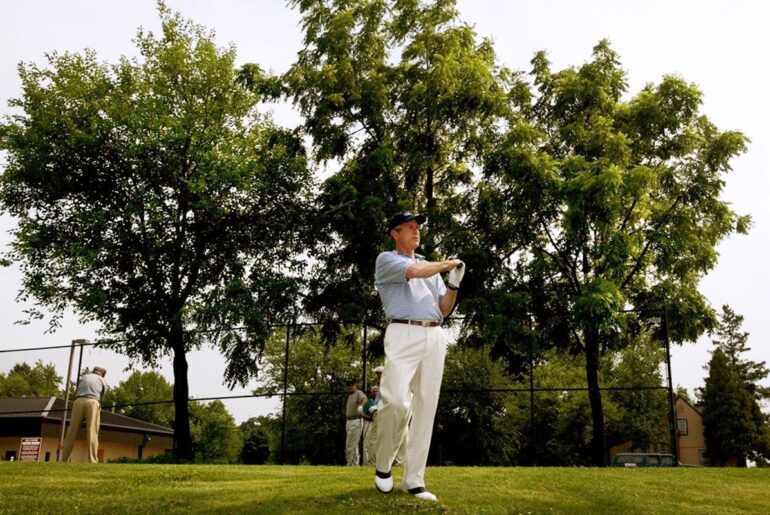How Oakmont Built The Most Intimidating Bunker In America l The Hole At l Golf Digest
oakmont Country Club has been terrorizing the world’s best players for over 100 years it was created in 1903 by a Pittsburgh iron and steel tycoon named Henry Clay Phones known as HC incredibly it was the only course he ever designed but since then it has earned a reputation for destroying confidence and snuffing out good rounds through an unrelenting combination of marble topped greens tilted fairways penal hazards and ankle deep rough no hole better represents Oakmont’s menace and existential threat to golf scores than the long uphill par4 third home of one of the game’s most formidable and instantly recognizable signatures the vast church pews bunker dominating the left rough hi I’m Derek Duncan the architecture editor at Golf Digest and today we’re going to break down the awesome intimidating third hole at Oakmont Country Club outside of Pittsburgh Pennsylvania from the beginning HC Phones wanted Oakmont to be one of the country’s toughest and most respected golf courses both HC and his son William Clark who went by WC were elite players who competed in championships all over the country including US amateurs in fact WC won the 1910 USM at the Country Club at Brooklyn so they knew good play and they knew all about the best and toughest courses in the first decades of American golf they anticipated how the newly introduced Haskell Ball was changing the distances players were hitting it to prepare it for this distance revolution they stretched Oakmont to an incredible 6,400 yd which was about 400 yardds longer than the average US course at the time oakmont was long and straddled two sides of a railroad ravine that’s now the Pennsylvania Turnpike but it had no bunkers and very few trees in its early years that’s because the phones wanted to see where players were hitting the ball before they spent money building hazards which was a fairly common approach to golf design in those days when WC took over the operations from his father in 1910 Oakmont began to change dramatically wc was a forward-looking thinker who had a chemical engineering degree from MIT and his approach to toughening up Oakmont was a combination of scientific tinkering with fundamentalistic notions of crime and punishment he believed that if a player hit a bad shot he deserved severe consequences a shot poorly played he famously said should be a shot irrevocably lost he and his green keepers including Emil Laughler known as Dutch who joined Oakmont in 1916 began adding bunkers exactly where good players missed their shots and even in places where they hit good shots they carved grassy pits all around the course and dug ditches across and alongside holes for both drainage and scoring enforcement throughout the 1920s and 30s Oakmont became a torture chamber for everyone who competed there i just come back from Oakmont and it’s the hardest golf course in the world at one point the course allegedly had around 350 bunkers almost 20 per hole as well as the fastest greens in the country phones and Laughler made changes to increase the difficulty so constantly it was almost impossible for members to keep up it’s no wonder they thought nothing of first building and then enhancing a hole like Oakmont’s third an already brutish 425 yardd uphill par4 starting just behind the second green the T-OT rides out to a fairway that slowly rises and then begins to tilt from right to left like most fairways at Oakmont it fluctuates between 25 and 30 yards wide and generally narrows the farther players drive it there’s danger on both sides on the left by the mighty church pew bunkers and on the right by a series of more formal deep bunkers benched into the rising hill the second shot moves farther uphill to a large green set on the top of a ridge if you’re hitting your second shot all you can see is the top of the flag stick if you’re lucky or the tall white aiming post in the distance the green is large nearly 10,000 square ft but it plays smaller because it’s crowned and tapers away downhill behind it it also has a steep false front so you have to get your approach shot all the way up to the top of the putting surface in order for it to hold in preparation for the 2025 US Open Oakmont’s record 10th architects Gil H and partner Jim Wagner made several consequential changes to the hole first they added a new T beyond and back right of the second green adding almost 40 yards to bring the new US Open length to 462 yards the five bunkers right of the fairway were also rebuilt and rearranged in a crescent pattern matching aerial images from the 1920s and 30s the first and fifth bunkers squeeze the fairway down to just 25 yds across a cross bunker 60 yards short of the green to the left also seen in old photos was added back in this is a looming nuisance for layup shots coming out of the bunkers hansen Wagner actually remodeled all the holes at Oakmont they rebuilt shifted and reoriented every bunker bringing down the total number from 175 to 168 that’s nowhere near the 300 plus from Oakmont’s heyday but it’s still an enormous amount of sand for any golf course their main goal was to reestablish the way the green pads were structured during the phone’s era between 1903 and 1946 their work included extending and sharpening the corners of each putting surface so they drop down more directly into the bunkers the expansions created new perimeter hole locations adding about 15% more pinnable space overall the green at the third also became larger as the corners were pushed out closer to the surrounding hazards and fall-offs some people think that making greens larger makes courses easier that’s somewhat true for higher handicap players who could use as much surface area as possible but for better players it actually reduces the amount of area that you can hit your shot if this was an existing green you might be able to put a hole location right here which is pretty tight but a good player can hit to the center and then have maybe a 15 20 foot putt to the hole when you enlarge greens it enables you to push them out closer to the hazards bunkers fall-offs now you can put a pin here so good players have to be more precise because they’re hitting to a smaller target area if they play to the middle of the green now they have a longer putt this could be 10 ft longer perhaps which drastically decreases their make percentage before the 2007 US Open the fall-off behind the third green was converted to short grass that low closely moan area always felt out of place at Oakmont it was the only green surrounded by fairway cut today that area is once again deep rough so balls will no longer trundle 30 feet down the slope playing from the rough just off the back of the green usually makes it slightly easier for better players more on that in a minute then we have the famous church pews bunker where Hansen Wagner added a new pew to extend the length of the hazard to 108 yards from tip to tail at this point we have to take a closer look at the church pews though the bunker is now one of the most feared and famous hazards in golf it didn’t exist until more than 30 years after Oakmont opened previously in this same spot phones and Laughafler had built seven slender individual bunkers known as the snake mounds for their long slithery shapes they were very similar to the parallel rows of bunkers that still line the left side of Pine Valley’s second hole prior to the 1935 open the snake mounds were connected by adding channels of sand around the perimeter to create one large contiguous bunker with seven grass berms inside that resembled benches or rows of pews the name church pews however didn’t come till later no one knows exactly who came up with the moniker it doesn’t seem to appear anywhere before 1962 when it was used in the club’s press release prior to the Open that year it also shows up in Sports Illustrated’s June Open preview although the writer Alfred Wright used the term in quotations as if signaling it was a common nickname wherever it came from the church pews have only grown in infamy and in size the club added an eighth pew before the 1969 US amateur won by Steve Melnik and it remained that way until 2005 observing that some players were driving it past the end of the bunker about 275 yards from the tea uphill the club along with consulting architect Tom Fazio built four new pews two massive ones on the nearest end near the tea and two more at the far end bringing the total number to 12 the additional pew added by Hansen Wagner in 2023 brings the size of the bunker to nearly 2/3 of an acre and the number of pews to an unlucky 13 because of its vast presence the church pew also comes into play on the fourth hole a par five coming back the opposite direction it’s actually more intimidating from the high fourth TE since you’re driving down toward it as it slants into the bend of the fairway beyond its ominous outsized trapezoidal presence the randomness of the punishment is what makes the Church Pews so scary players never know what they’re going to get when they hit into it if the drive just trickles in you might have a clear path directly up the side channel toward the green the ball might even bounce onto the top of one of the grass pews leaving a decent lie at least in the past when they were mowed at rough height in recent opens the fesky rough on top of the pews has been left long and shaggy and the BMS have become even taller through recent reconstructions 3 to four feet in some places if the ball settles in the sand between the elevated pews it can prevent you from advancing it very far if it’s nestled against the foot of the burm you might have to play out sideways believe it or not there’s actually a second set of church pews at Oakmont the bunker left of the 15th fairway is also built with similar BMS though historically they’ve been connected to the hill on the back side members often called them the piano keys though their shapes been modified and reduced during the recent renovation as intimidating as the church pews and the deep bunkers at Oakmont are they’re nowhere near as punitive as they once were because of the hard clay soils the original bunkers were fairly shallow and even when filled with the regular pebbly sand dredged from the nearby Alageney River they weren’t penal enough for phones so he invented a special rake for the Oakmont bunkers it had a wide head with V-shaped tines loaded down with a 100-lb weight when the rake was pulled across the sand it made deep furrows or ruts that ensured golf balls would settle in the bottom of the grooves the only way to play bunker shots out of the furrows at Oakmont was with some kind of explosion oakmont used the Furrows until the 1960s before the rakes were retired in large part due to disputes with the USGAA and professional players during opens who thought the Furrows were unfair during the last seven US Opens at Oakmont the average winning score has been nearly 281 strokes that’s within a few shots of par either way since sometimes the course is set up as a par 72 sometimes as par 71 and most recently is par 70 as in 2025 as hard as the bunkers are the greatest difficulty at Oakmont comes from the greens since 1904 they’ve been considered some of the fastest and most frustrating in the country phones wanted to push them to the limits so he had early green keepers cut the grass even shorter down to 1/15th of an inch in 6t diameters around the hole ensuring that balls were accelerating toward the cup on all putts oakwan also developed an early method of rolling their greens using steel barrels that weighed a quarter ton to flatten the grass even further sam Sneed once quipped that during a tournament he marked his ball with a dime and when he went back to replace it the coin had slipped off the green those greens are planted with an old unique strain of pure poa anua grass and are miracles of slope and speed at certain times of the year they measure 14 or 15 feet on a stimp meter in fact Oakmont is the reason we know about green speeds the stint meter device for measuring how quick they play was invented at Oakmont by member Ed Stimson stimson was on hand observing the 1935 US Open when he thought the greens were far too fast after he watched Jean Saren putt his ball into a bunker saren had two putts on that green Stimson remembered but they were not in succession to prove the greens were too fast Stimson created what is basically a three-foot ramp originally made of wood and now made of aluminum with a notch for a golf ball and a channel for it to roll down to use it you slowly lift one end until the ball begins rolling down the ramp onto the flattest section of the green the user can find the distance of the roll is measured in feet you repeat the exercise in the opposite direction averaged the two measurements and that’s now known as the stint meter speed the US didn’t begin using the stint meter to measure US open green speeds until 1976 then in a nationwide measurement of green speeds in 1977 the USJ reported that the average speed for all US courses was about 6 1/2 ft with private courses a touch faster some of the greatest courses like Shinikok Hills Winged Foot West and Augusta National had stint meter readings between 7’2 and 7’11 oakmonts were 9 ft 8 by far the fastest in the country for reference a flat Lenolium floor has a stint meter reading of 21 ft that should put those 15t days at Oakmont in perspective by the early 1980s US Open courses were routinely getting above 11 ft but oaks were always faster it’s the distinctive contours of the greens that allow for these higher speeds where the greens at courses like Augusta National or Oakland Hills have big rolling contours oaks are more tilted like large panes of glass angled in different directions the ball glides and coasts on them and it can be hard to get it to settle as Dustin Johnson found out when his inadvertently moved on the fifth green during the final round of the 2016 Open and he was assessed a one-stroke penalty after the fact fortunately it only cut his margin of victory from four strokes to three the speed and tilt of the Greens impact everything from approach shots to chips to lag putts and the combination can torment even those who know them the best in the 1962 Open Arnold Palmer who grew up 35 miles away and had played Oakmont countless times had 10 three putts this includes three in the playoff with Jack Nicholas which he lost by three strokes the ridgetop green at the third is not as tilted or as severe as some others but whole locations around the perimeter can be treacherous the hole possesses all of Oakmont’s issues and obstacles as well as some that are uniquely its own members know to be conscious of the alignment of the T- box it’s aimed directly at the five bunkers right of the fairway many people think that being in those bunkers is worse than being in the church pews they’re incredibly deep and there’s little chance for amateurs to do anything more than wedge out so golfers who are afraid of the church pews often leave themselves in a worse position by favoring the right side of the third unfortunately the best place to approach the green is from the left side of the fairways right alongside the church pews the ground is relatively flat there and more of the green and flag stick are visible but to get to that position you have to challenge the bunker as a result most golfers just try to drive down the middle leaving a severely uphill second where only the top of the flag can be seen if that shot is not hit solidly it’s going to come rolling back down the fairway off that big false front if it’s knuckled over the green it tumbles into the rough leaving a tricky uphill pitch shot probably from a bad lie tiger Woods would have actually preferred that result in the final round of the 2007 US Open tied for the lead from the middle of the fairway he misjudged his blind approach and his ball sailed through the green all the way down to the bottom of the collection area that left him facing a 50-ft pitch back up to a green sitting well above him he hit that shot too firmly and the ball rolled past the hole and onto the fringe from there it took him three more strokes to get down and he walked off the third with a six suddenly looking up at the scoreboard at three other players normally you’d be relieved to get a hole as hard as the third over with early in the round but at Oakmont big numbers are never easy to overcome no matter when they occur bogey and doubles have a way of sticking and they follow around players like Ghost even though Tiger rided the ship and played even par the rest of the way it wasn’t enough in the end he lost to Anel Cabrera by a single shot the third hole does everything the phones wanted a hole to do it gives no profound advantage to good shots and absolutely can massacre poor ones that was Tiger’s fate in 2007 his poor shots on number three were in fact irrevocably lost and that’s just the way the phones wanted it thanks for watching if there are other famous holes you’d like to see us break down please let us know in the comments below
Welcome to ‘THE Hole At’, where Golf Digest’s Derek Duncan (our go-to for all things golf course architecture) breaks down the hidden histories behind the most famous holes in golf. In this episode, Derek dives into the famous uphill Par-4 3rd hole at Oakmont Country Club. From its original bunkerless design, to the expansion of it’s torturous Church Pews bunker, to remaining one of the most daunting and critical holes of U.S. Opens at Oakmont, Derek explores the fascinating history behind one of the game’s most iconic golf holes.
What’s your favorite part of Oakmont’s 3rd hole? Let us know!
Like, Subscribe and Comment with any questions or ideas for future episodes!
Host: Derek Duncan
Producer: Ben Walton
Editor: Alex Franklin
Audio: Tony Leonardo
Executive Producer: Christian Iooss
Follow GolfDigest:
Instagram / golfdigest
Twitter https://x.com/GolfDigest
Subscribe to Golf Digest on YouTube ►► http://bit.ly/golfdigestyoutubesub
Grab a Golf Digest + membership ►► http://glfdig.st/mFqM50OXuv4
ABOUT GOLF DIGEST
Home of the Hot List, Golf Digest +, news and trends, Golf Digest is the definitive destination for all things golf.
Chapters:
0:00 Intro
0:52 The Original Design
3:10 How To Play It
3:58 New Changes For The 2025 Open
6:45 The Church Pews Bunker
10:40 The Oakmont Greens
11:30 The Stimpmeter
14:20 Why The 3rd Is So Hard
15:15 Tiger 2007
16:15 Fownes’ Legacy








19 Comments
Loving these course features
This is a really well done video. Thanks for the information.
Which hole should we break down next? Let us know in the comments!
Golf digest continues to put up quality content. Other sport channels should take note. The pacing, the message, the storytelling, all way above the standard these days.
I am nervous for the boys this weekend 😂
Just don’t hit there, problem solved!
/s
I love this series! I got the chance to play Oakmont a few years ago. It is every bit as menacing as they say.
I imagine the 8th at Oakmont must have a good story behind it.
I would also love to see an episode on a hole at Torrey Pines
i recall years ago Tiger calling this bunker STUPID
An absolute crime it has less than 2K views in two hours. These videos are incredible down to earth in depth, but not too long thank you so much for doing them.
Fascinating to hear about the Stimp readings back in the 70s.
I wonder how fast the greens were back in 1935 when Mr Stimpson made his observation about the greens at Oakmont. Zipping along at 7?
That was awesome
😮I'll watch 72nd Hole
Evil rakes
When you see those bunkers in real time, your reaction is Holy S..T
This isn't a course for us average players. Having said that, it's a perfect U.S. Open course. Even par should be a winning score
We need one of these for the 8th hole
Awesome video
Great video, always look forward to these breakdowns with Derek every major.
Loved learning more about Oakmont and enjoyed seeing the archival photos and footage.
We'll see you again at Royal Portrush perhaps?
loving the historical aspect including quotes, pictures, videos, and stories of how the hole was played in the past